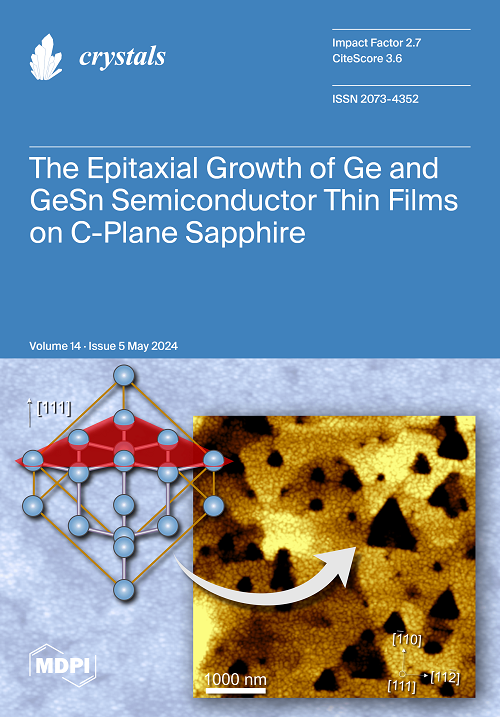Review of the Properties of GaN, InN, and Their Alloys Obtained in Cubic Phase on MgO Substrates by Plasma-Enhanced Molecular Beam Epitaxy
IF 2.4
4区 材料科学
Q2 CRYSTALLOGRAPHY
引用次数: 0
Abstract
Gallium nitride (GaN) semiconductors and their broadband InGaN alloys in their hexagonal phase have been extensively studied over the past 30 years and have allowed the development of blue-ray lasers, which are essential disruptive developments. In addition to high-efficiency white light-emitting diodes, which have revolutionized lighting technologies and generated a great industry around these semiconductors, several transistors have been developed that take advantage of the characteristics of these semiconductors. These include power transistors for high-frequency applications and high-power transistors for power electronics, among other devices, which have far superior achievements. However, less effort has been devoted to studying GaN and InGaN alloys grown in the cubic phase. The metastable or cubic phase of III-N alloys has superior characteristics compared to the hexagonal phase, mainly because of the excellent symmetry. It can be used to improve lighting technologies and develop other devices. Indium gallium nitride, InxGa1−xN alloy, has a variable band interval of 0.7 to 3.4 eV that covers almost the entire solar spectrum, making it a suitable material for increasing the efficiencies of photovoltaic devices. In this study, we successfully synthesized high-quality cubic InGaN films on MgO (100) substrates using plasma-assisted molecular beam epitaxy (PAMBE), demonstrating tunable emissions across the visible spectrum by varying the indium concentration. We significantly reduced the defect density and enhanced the crystalline quality by using an intermediate cubic GaN buffer layer. We not only developed a heterostructure with four GaN/InGaN/GaN quantum wells, achieving violet, blue, yellow, and red emissions, but also highlighted the immense potential of cubic InGaN films for high-efficiency light-emitting diodes and photovoltaic devices. Achieving better p-type doping levels is crucial for realizing diodes with excellent performance, and our findings will pave the way for this advancement.通过等离子体增强分子束外延技术在氧化镁基底上获得立方相氮化镓、氮化铟及其合金的特性综述
氮化镓(GaN)半导体及其六方宽带 InGaN 合金在过去 30 年中得到了广泛的研究,并开发出了蓝光激光器,这是至关重要的颠覆性发展。高效白光发光二极管彻底改变了照明技术,并围绕这些半导体催生了一个巨大的产业,除此之外,利用这些半导体的特性还开发出了多种晶体管。其中包括用于高频应用的功率晶体管和用于电力电子设备的大功率晶体管等,这些器件都取得了卓越的成就。然而,人们在研究以立方相生长的氮化镓和氮化铟合金方面投入的精力较少。与六方相相比,III-N 合金的稳定相或立方相具有更优越的特性,这主要是因为它具有出色的对称性。它可用于改进照明技术和开发其他设备。氮化铟镓(InxGa1-xN 合金)具有 0.7 至 3.4 eV 的可变带区间,几乎覆盖了整个太阳光谱,因此是提高光伏设备效率的合适材料。在这项研究中,我们利用等离子体辅助分子束外延(PAMBE)技术在氧化镁(100)衬底上成功合成了高质量的立方 InGaN 薄膜,并通过改变铟的浓度在可见光谱范围内实现了可调发射。通过使用中间立方氮化镓缓冲层,我们大大降低了缺陷密度,提高了结晶质量。我们不仅开发出了具有四个 GaN/InGaN/GaN 量子阱的异质结构,实现了紫光、蓝光、黄光和红光的发射,还凸显了立方 InGaN 薄膜在高效发光二极管和光伏器件方面的巨大潜力。实现更好的 p 型掺杂水平对于实现性能卓越的二极管至关重要,而我们的研究成果将为这一进步铺平道路。
本文章由计算机程序翻译,如有差异,请以英文原文为准。
求助全文
约1分钟内获得全文
求助全文
来源期刊

Crystals
CRYSTALLOGRAPHYMATERIALS SCIENCE, MULTIDIS-MATERIALS SCIENCE, MULTIDISCIPLINARY
CiteScore
4.20
自引率
11.10%
发文量
1527
审稿时长
16.12 days
期刊介绍:
Crystals (ISSN 2073-4352) is an open access journal that covers all aspects of crystalline material research. Crystals can act as a reference, and as a publication resource, to the community. It publishes reviews, regular research articles, and short communications. Our aim is to encourage scientists to publish their experimental and theoretical results in as much detail as possible. Therefore, there is no restriction on article length. Full experimental details must be provided to enable the results to be reproduced. Crystals provides a forum for the advancement of our understanding of the nucleation, growth, processing, and characterization of crystalline materials. Their mechanical, chemical, electronic, magnetic, and optical properties, and their diverse applications, are all considered to be of importance.
 求助内容:
求助内容: 应助结果提醒方式:
应助结果提醒方式:


